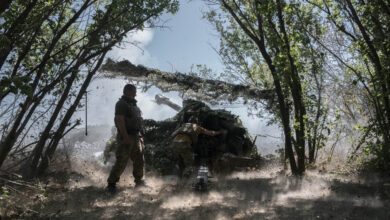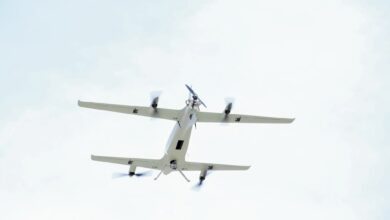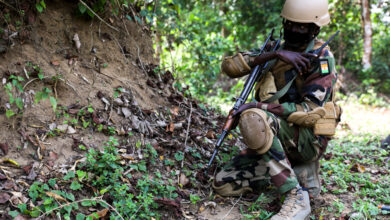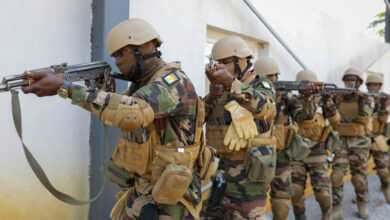At least one Chadian soldier was killed and 12 other soldiers were injured during a Multinational Joint Task Force operation against Islamic State fighters in the Baga area of Nigeria’s Borno state, the Nigerian Army said.

On Friday, June 21, “troops of Sectors 2 and 3 of the Multinational Joint Task Force comprising Nigerians and Chadians with coordinated Air Interdiction, embarked on clearance operations” in Cross Kauwa, Baga and Doron Naira in the Lake Chad area of Nigeria, the army said in a release published on Facebook that included several images of dead bodies.
During the operation, which was “aimed at disrupting BHT [Boko Haram Terrorist] supplies and line of communications,” one Chadian soldier was killed and 12 other soldiers were injured, the release said without divulging the nationality of the injured troops.
It said “42 BHTs were neutralized while several others were wounded,” adding that further details would be provided later.
ISIS had acknowledged military operations in the area overnight on Wednesday, claiming in a statement that fighters from its Islamic State West Africa Province affiliate had repelled “an attack by the apostate Nigerian Army in the town of Baga,” and that during the clashes, the insurgents “detonated an explosive device against one of their vehicles, resulting in damage, loss and injury to a number of them.”
Update June 23 In a statement released on Saturday, ISIS claimed ISWAP fighters repelled an attack by “African Crusader forces” – a term it uses for the MNJTF – in “Garno” in the Lake Chad area of Borno state.
ISIS said “at least 15” soldiers were killed and others injured in a suicide car bomb attack, naming the SVBIED bomber as Abu Hurayra al-Ansari. ISIS released an image of the bomber standing beside a partially up-armored pickup truck before the attack, and a second image purportedly of smoke from the explosion.
In a later release, ISIS propaganda agency Amaq said clashes between militants and MNJTF troops in “Garno” on Friday lasted several hours and “the remaining soldiers withdrew” after the SVBIED attack.
The location of “Garno” and whether the incident is related to the MNJTF operation in the Baga area is unclear
ISWAP in Borno state
Since July last year, ISWAP has intensified attacks on military targets, killing dozens of soldiers and overrunning bases, mainly in the Lake Chad area of Nigeria, Chad and Niger where it is the dominant insurgent group.
In late December, when ISWAP fighters overran two military bases in and around the fishing town of Baga, east of Borno state capital Maiduguri on the shores of Lake Chad. Images released by Islamic State appeared to show large quantities of weapons, vehicles and other equipment captured during the fighting in and around Baga.
ISWAP also attacked nearby military locations in Cross-Kauwa, Kukawa, Kekeno and Bunduram, and made three unsuccessful attempts to overrun Monguno, prompting preparations for a military offensive in the area late last year.
The fighting triggered a “massive displacement” of civilians to already overcrowded camps in Monguno and Maiduguri, the United Nations said in January.
Nigerian troops reportedly returned to Baga on January 10, but the town – and the wider area – has been contested since the initial onslaught in December.
More recently early June, ISWAP fighters attacked military bases south of Baga in Marte, Dikwa and Kirenowa.
In May, ISIS released video featured extensive battle footage of attacks against military bases which appear to have been carried out between November and January, including attacks in Kareto, Arege and Baga in the Lake Chad area of Borno state.
The regional counter-insurgency Multinational Joint Task Force which comprises personnel from Chad, Cameroon, Niger, and Nigeria, launched Operation Yancin Tafki on February 21 to battle the insurgents. It has said the cross-border operation is aimed at “making islands and other settlements in Lake Chad untenable for Boko Haram Terrorists.”
In recent months ISWAP has also conducted a series of attacks against towns north of Maiduguri. In the most recent incident, ISIS claimed 12 Nigerian soldiers were killed in a raid on Gajiram, around 70 km (44 miles) north of the state capital. Other reports put the death toll at up to 28.
The number of military casualties caused in recent attacks is unclear. The Nigerian military seldom comments on the ongoing counter-insurgency operations, and tends to downplay the insurgents’ effectiveness, rarely acknowledging engagements and seemingly understating military casualties and equipment losses.
In one case, after ISWAP fighters in April attacked a Nigerian military base in Sabon Gari near Biu, around 135 km southwest of Maiduguri, the Nigerian Army described reporting on the incident as “unsubstantiated” and “fake,” saying it was the work of “Boko Haram sympathizers.”
A month later on May 24, ISWAP fighters ambushed a convoy that was transporting civilians from Sabon Gari to Damboa. Media reported that between five and 25 Nigerian soldiers died in that attack, but again the Nigerian Army described those reports as “fake news” and denied there had been any attacks on military personnel in Borno state.
Decade-long cross-border insurgency
The jihadist group known as Boko Haram began its bloody insurgency in northeastern Nigeria in 2009, but it has since spread into neighboring Niger, Chad and Cameroon, prompting a regional military response. More than 27,000 people have been killed and two million others displaced, sparking a dire humanitarian crisis in the region. The U.S. assesses that Boko Haram and ISWAP have been responsible for over 35,000 deaths since 2011.
Boko Haram split into two factions in mid-2016. One, led by long-time leader Abubakar Shekau, is notorious for suicide bombings and indiscriminate killings of civilians. Shekau pledged allegiance to ISIS leader Abu Bakr Al-Baghdadi in March 2015, but ISIS central only gives formal backing to the other faction, which it calls Islamic State West Africa Province.

The ISWAP faction, which largely focuses on attacking military and government targets, was led by Abu Mus’ab Al-Barnawi, but in March, audio recordings revealed that ISIS appointed Abu Abdullah Idris bin Umar, also known as Ibn Umar al-Barnawi, as leader. Despite releasing several videos featuring ISWAP since, ISIS has not yet made a public statement confirming the change.
Since May, Islamic State has attributed insurgent activities in the Mali-Burkina Faso-Niger tri-border area to its West Africa Province affiliate, rather than to what was previously known as Islamic State in the Greater Sahara. In a June 15 ISIS propaganda video, ISWAP militants purportedly in Nigeria, Mali and Burkina Faso were shown reaffirming their pledge of allegiance to ISIS leader Baghdadi.











